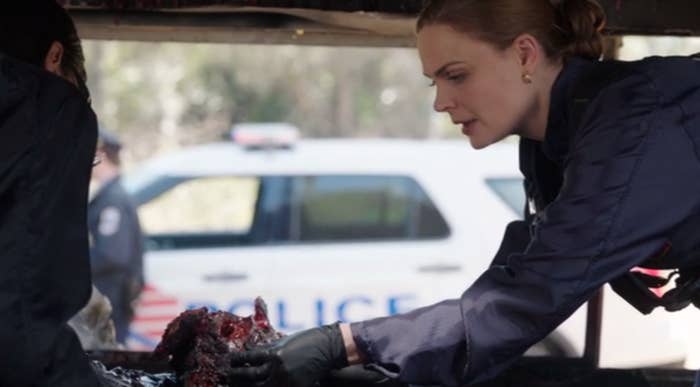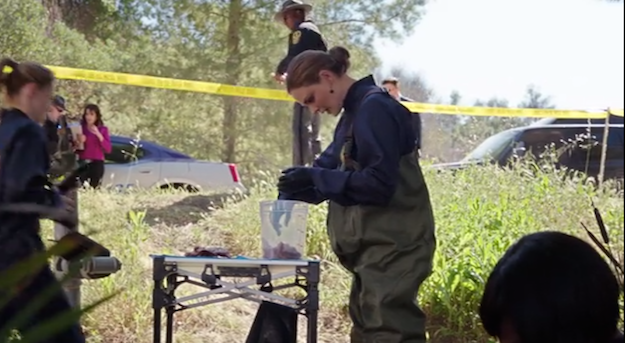
If you watch Bones with any regularity, you have seen Dr. Temperance Brennan (Emily Deschanel) identify the race of human remains dozens and dozens of times. The forensic anthropologist often looks at only one element of the skull — the victim's "zygomatic process," the "orbital margins," the "ascending ramus" (which are more or less cheekbones, eye sockets, and jaw, respectively). "The projection of the nasal bones suggests Caucasian," Brennan said in the April 2 episode of Bones.
And because it comes so easily to her, you would never know that "race" is not a biological reality.
In a typical report for the Los Angeles coroner, Elizabeth Miller, Ph.D. — the consulting anthropologist to L.A. County's Department of Medical Examiner-Coroner — will note the "race" of an individual because it's required. But, she told BuzzFeed News, "I usually say something like 'white,' which includes a long list, and then as a caveat, I put, 'This bears no relationship to the race an individual considers themselves, and has no bearing on hair color or skin type.'"
"It's the hardest thing to determine, it is the least accurate, and I'm never surprised when I'm wrong," said Miller, who's also a professor of anthropology at California State University, Los Angeles.
"Pardon the pun: It's not a black-and-white issue," she added.

Human bodies are quite variable, as Joseph T. Hefner, Ph.D., a professor at Michigan State University certified by the American Board of Forensic Anthropology, detailed in a 2009 article in the Journal of Forensic Sciences. In a set of 747 skulls, Hefner found that each one showed at least one trait that could have placed the decedent in a different ancestral group than the one they actually belonged to. Furthermore, among those 747 skulls, no individual had all of the traits expected of that person's ancestry. "No one was a 'perfect specimen,'" Hefner told BuzzFeed News. "That's the single most important statement in the paper."
If an anthropologist has determined that an individual is an American white female, Hefner explained, they will often note only the traits of the skeleton that are in line with their assessment and not those traits that are suggestive of different results. The more experience a forensic anthropologist has, the better that forensic anthropologist will be at identifying the ancestry of an individual. But at the same time, that experience makes you "more hesitant" to make those calls, Hefner said. The more you see, the more you realize just how hard it is to fit any individual into a neat package.
"Anthropologists, probably in the '60s and '70s, started to realize that the whole concept of race was flawed, not biologically valid," Eric Bartelink, Ph.D., a professor at California State University, Chico, and director of the university's Human Identification Laboratory who is also ABFA–certified, told BuzzFeed News. When forensic anthropologists determine the ancestry of an individual, they are identifying "a population where they most likely trace their genes from," Bartelink said.
Researchers, he explained, enter a series of traits into a statistical program that determines an individual's probable heritage. "I just had a case recently where the person self-identified as caucasian, but the program really couldn't classify the person as being from any group with any accuracy," Bartelink said. "That should give you pause."

As for terms like "negroid," "caucasoid," and "mongoloid," which pop up on Bones, Bartelink said they have "become pretty antiquated, and most people in the field, unless they're over 60, have kind of let it go." He singled out "mongoloid" in particular as "offensive," but Hefner felt more strongly: "It boggles my mind — some prominent forensic anthropologists still use those same terms," he said. "It puts us back in the 19th century as a field, when we've come so much further than that."
"Mongoloids," he added, "were 'a yellow, melancholy people full of avarice.'"
Anthropologist C. Loring Brace writes that the term "caucasoid" was used in a doctoral dissertation in the late 18th century to mean "the least modified descendants of the people who allegedly got off the Ark at Mount Ararat and therefore the best representatives of of what God intended when he created human beings in the first place."
Hefner's 20th-century aim is not to classify people into broad ancestral categories, but to narrow the population from which an individual hails — Holland, for example, or Guatemala, rather than "Caucasian."
When Brennan makes her declarations with such ease using one facet of a skull, "it harkens back to the typology days, when everybody seemingly fit into one discrete package," Hefner said of the Bones character.
"It makes good TV, I guess, but it's perpetuating the old myth," he said. (When reached by BuzzFeed News, Bones producers were not available to comment on this story.) "Race doesn't exist, because it's human variation that we're talking about."
